Harvesting fruits and vegetables from your backyard is one of life’s simple joys. It is very gratifying and rewarding to know that the small seeds you have once sowed are now yielding healthy and fresh produce. But what if it is being infested by tomato and tobacco hornworms? Will that sense of happiness and fulfillment go away?
Tomato and tobacco hornworms: Are they related? They are closely related as both of them feed on similar plant species under the Solanaceae or nightshade family. However, tomato hornworms are the nymphs of the five-spotted hawk moths while tobacco hornworms are the larvae of the tobacco hawkmoths.
This article will discuss if are these hornworms are related to each other, tackle some important matters such as the similarities and differences of these tiny creatures, what they eat, and the effective strategies of getting rid of them.
Are Tomato and Tobacco Hornworms the Same?
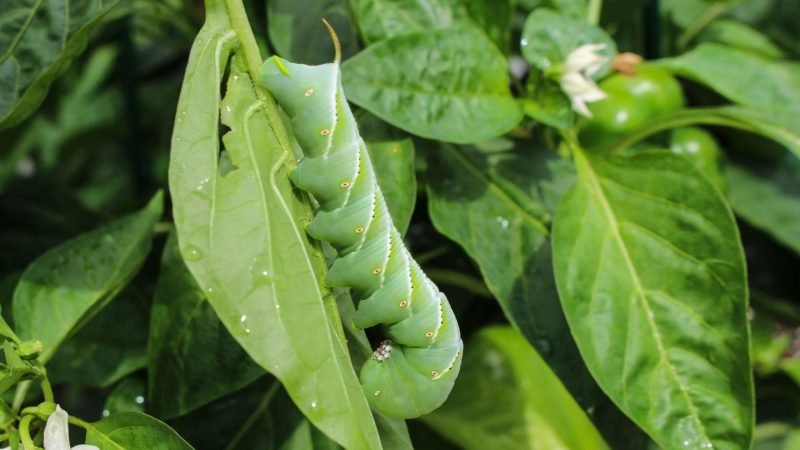
The tomato hornworms (Manduca quinquemaculata) and tobacco hornworms (Manduca sexta) are common pests found in your gardens. These worms are somewhat the same since they are closely related to each other.
Both are the larval stage of gray moth species, particularly the hummingbird or hawkmoth (Carolina sphinx). They also have similar appearances and habits and loves to feed on vegetation under the Solanaceae or nightshade species.
The Hornworm Life Cycle
There are four stages in the life of a hornworm: Egg, Larvae, Pupae, and Adult. The eggs are round to oval in shape, 1.5 millimeters in size, and white to light green in color. Once these eggs are hatched, tiny caterpillars will emerge and will start to feed on leaves and plants.
They will grow and develop fully after three to four weeks and will subsequently go down on the soil to burrow. During this stage, the caterpillars will pupate for at least two weeks and will evolve into second-generation moths, repeating the same cycle to produce succeeding generations of moths.
What Do Tobacco Worms Turn Into?
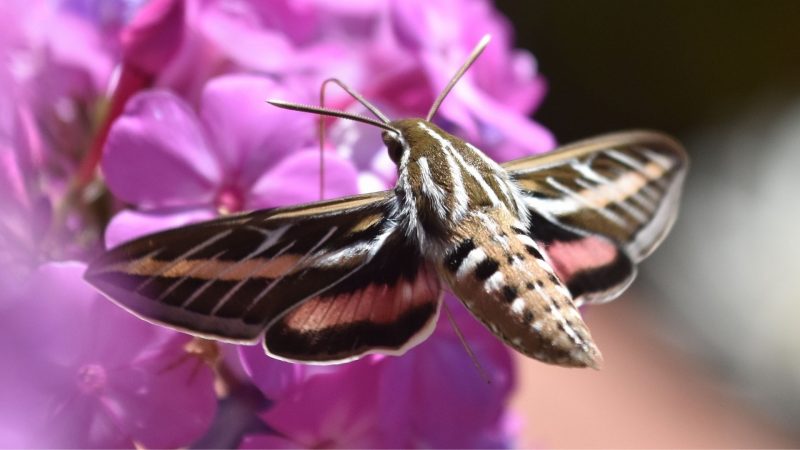
When tobacco hornworms turn into adults, they become a tobacco hawkmoth. These moths’ bodies are filled with six pairs of yellow to orange spots, while their wings have a white, black, and brown color.
Their frontal wings are wide and typically measure 3.75 to 4.75 inches, while their hindwings are smaller in size and have dark and light striations. These wings fold when these moths are placed in a resting position, giving them the chance to disguise and camouflage themselves from predators.
Furthermore, these moths regularly fly from one flower to another in order to extract nectar. This is the reason why they are regarded as excellent pollinators.
What Does a Tomato Hornworm Turn Into?
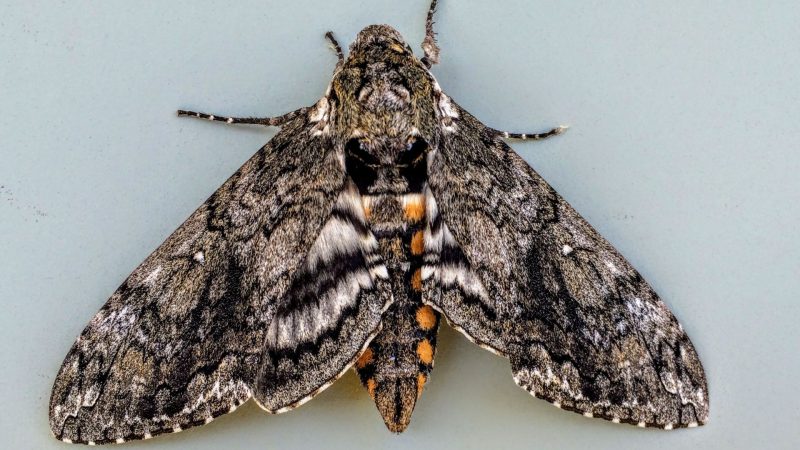
When a tomato hornworm reaches maturity, they become five-spotted hawkmoths. These insects have giant and large body structures with yellow to orange bands on their abdomens.
Their forewings are bigger than the hindwings and have brown, white, and gray patterns. They fly in a gracious and charming manner, which is why they are also called hummingbird moths.
Just like the adult moths of tobacco hornworms, they also visit flowers in order to get nectar.
What Do Hornworms Eat?

In general, hornworms feed on Solanaceous plants like eggplant, potato, tomato, tobacco, and pepper. They also eat various kinds of weeds such as jimsonweed, nightshade, and horsenettle.
Do Tomato Hornworms Eat Tobacco?
Yes, they do. Since tobacco plants are part of the Solanaceous family, tomato hornworms would also feed on tobacco leaves. You would usually see these larvae feeding on the leaf surfaces of the plant.
Do Tobacco Hornworms Eat Tomatoes?
Yes, tobacco hornworms feed on tomatoes, specifically the leaves. They also consume the green fruit occasionally if they have already successfully defoliated the leaves.
How Long Can Hornworms Live?
Since they are regarded as the larval versions of gray moths, tomato and tobacco hornworms may last for three to four weeks. After the said time, they will go down to the soil and pupate until they develop into adult insects.
What Animals Eat Tomato Hornworms?
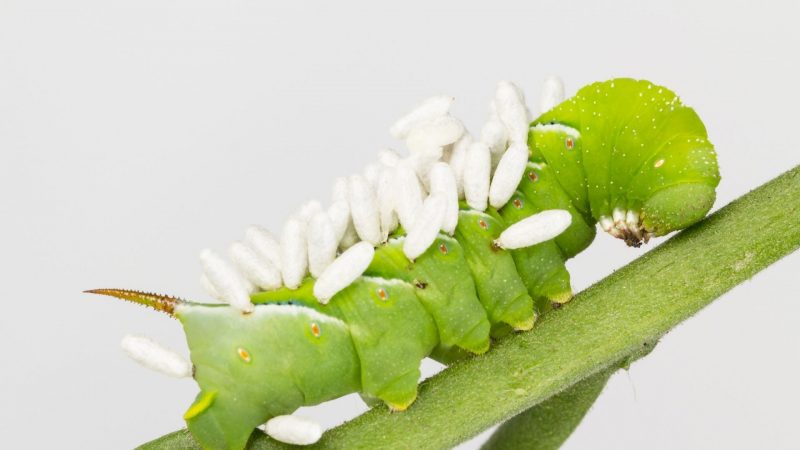
One of the prominent creatures that eat tomato hornworms is the braconid wasps (Cotesia congregata). The larvae that emerge from the eggs of these wasps are laid on the hornworms.
Braconid wasp larvae feed on them until they reach the pupal stage. Cocoons are formed on the top of the hornworms, which appear like white rice bulging from the latter’s bodies. Once these wasps go out from their cocoons, they will eliminate the hornworms and will look for other moth larvae to attack.
Other notable tomato hornworm predators are green lacewings, lady beetles, and paper wasps (Polistes spp.).
What Eats Tobacco Hornworms?
Just like tomato hornworms, the common predators of tobacco hornworms are paper wasps, green lacewings, lady beetles, and other parasitic wasps. There are also vertebrates that eat and ingest hornworms, such as small mammals and birds.
Are Tobacco and Tomato Hornworms Poisonous?
These species may have horn-like figures on their bodies, but they are not poisonous. They do not emit dangerous or harmful substances, so touching them may not pose a risk.
Are Tomato and Tobacco Hornworms Bad?
Although tomato and tobacco hornworms are generally harmless, they can be a threat to plants and vegetation. Their larvae species regularly strip off the foliage of certain vegetables such as tomatoes, eggplants, and potatoes.
Tomato Hornworm vs. Tobacco Hornworm | Similarities and Differences
Distinct Similarities
- Both of their favorite plants to eat are Solanaceous crops such as tomatoes, tobaccos, pepper, potatoes, and eggplants. They also attack and feed on weeds like nightshade, horsenettle, and jimsonweed. Additionally, they frequently visit different flowers in order to get nectar.
- Both have five pairs of prolegs, horns at the end of their bodies, bigger forewings compared to their hindwings, and measure 3 to 4 inches.
- The moths of these worms are large in size and have wide wings. They follow the same life cycle upon hatching and pupate at least 4 to 6 inches under the soil.
- After mating, the females of these caterpillars lay their eggs on the leaves of their hosts.
Distinct Differences
- As to the presence of patterns on the sides of their bodies, tomato hornworms have V figures, while tobacco hornworms have diagonal bands.
- Tomato hornworms have black horns, while tobacco hornworms have red horns.
- The tomato hornworms usually transform into five-spotted hawk moths, while tobacco hornworms become Carolina sphinx moths or tobacco hawkmoths.
Should You Eliminate Tomato Hornworms?
If it causes too much hassle in your gardens and backyards, it may be beneficial to eliminate them. However, if they are not much of a problem, you can just leave them on their habitats or manually remove them from the plants and transfer them to a different site.
Related: How to Stop Bugs From Eating Your Plants? | A Complete Guide
How Do You Get Rid of Hornworms Naturally?
There are various natural ways of getting rid of hornworms. It may be done manually or through the aid of biological agents. The following sections will be discussing this in detail:
What Do You Do With Tobacco Hornworms?
The following are the helpful tips in getting rid of tobacco hornworms naturally:
- Look for the presence of tobacco hornworms in your backyard plants and vegetables. They may be difficult to spot since they can disguise themselves, so a keen and curious eye would be a big help.
- Manually pick the hornworms from the plants and eliminate them, if necessary, by putting them in a container with a soap and water mixture.
- Employ biological control through the use of Bacillus thuringiensis (Bt). Bt is a kind of bacteria found on the soil, releasing a protein that acts as a toxin when ingested by moth larvae.
- Constantly till and cultivate the soil around plants if you suspect a hornworm infestation. This will enable you to disrupt the pupation of larvae that may be developing in it.
- Allow various animals from preying or eating on tobacco hornworms. For example, if you see braconid wasps that are getting out from their cocoons or feeding on the hornworm’s bodies, do not interrupt or disturb their activities.
How Do You Control Tomato Hornworms?
In order to successfully remove the presence of tomato hornworms, the following strategies must be implemented:
- Regularly monitor and observe the plants and vegetables for the existence of tomato hornworm infestation.
- Carefully remove the tomato hornworms by hand if you see them lurking on your plants.
- Place the handpicked tomato hornworms in a soap solution if it is necessary to eliminate them or transfer them to a different location.
- Utilize organic biological agents like Bacillus thuringiensis (Bt) is naturally causing the death of tomato hornworms.
- Practice crop rotation in order to control weed and pest infestation.
How Do You Keep Tomato Hornworms Away?
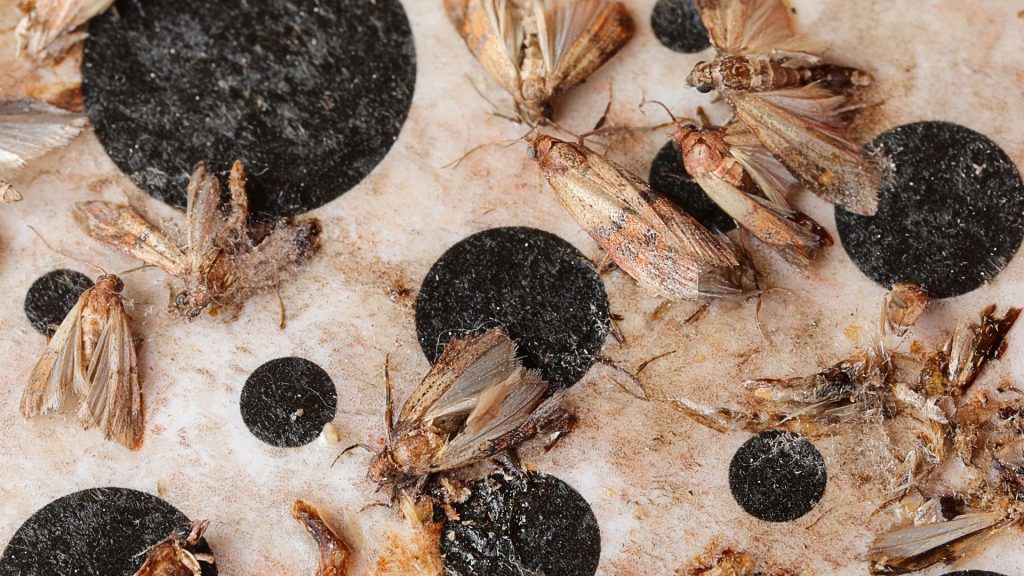
These are the best techniques in keeping the tomato hornworms away from your vegetation:
- Use organic and safe worm repellents such as Bacillus thuringiensis (Bt), Indoxacarb , Tebufenozide, Spinosad , and synthetic pyrethroids .
- Frequently till the soil in areas where the infestation of tomato hornworm is evident to prevent any pupae from maturing.
- Remove the weeds to minimize the locations where hornworms can possibly lay their eggs.
- Use moth traps to avert the possibility of females hatching eggs.
- Encourage the activities of their natural enemies at a tolerable degree so that the latter will hunt and exterminate them.
Summary
Tomato and tobacco hornworms may transform into beautiful and attractive moths, but when it continues to attack and damage plants, it would be better to get rid of them through natural or chemical means. However, if they do not pose an extreme risk, you can just leave them or pick them by hand and transfer them to a different location.
Related: Top 10 Worst Pests That Can Infest Your House | Identification and Control Guide
List of Sources
Byron, M., & Gillett-Kaufman, J. (2017). Common Name: Tobacco Hornworm.
Hahn, J. (2020). Tomato Hornworms in Home Gardens.
Pavuk, D. (2009). The Tomato Hornworm and the Tobacco.
University of Massachusetts Amherst. (2020). Hornworm, Tomato.
VanZandt, N. (2020). Stalking the Hornworm.
- Bed Bug Surge 2025: How to Detect, Prevent, and Safely Eliminate Infestations in Top U.S. Cities - June 18, 2025
- Asian Needle Ants Invade US Homes: 2025 Guide to Identification, Risks, and Effective Control - June 11, 2025
- New World Screwworm Alert: How US Livestock Owners Can Prevent Outbreaks and Protect Herds [Summer 2025 Update] - June 8, 2025
